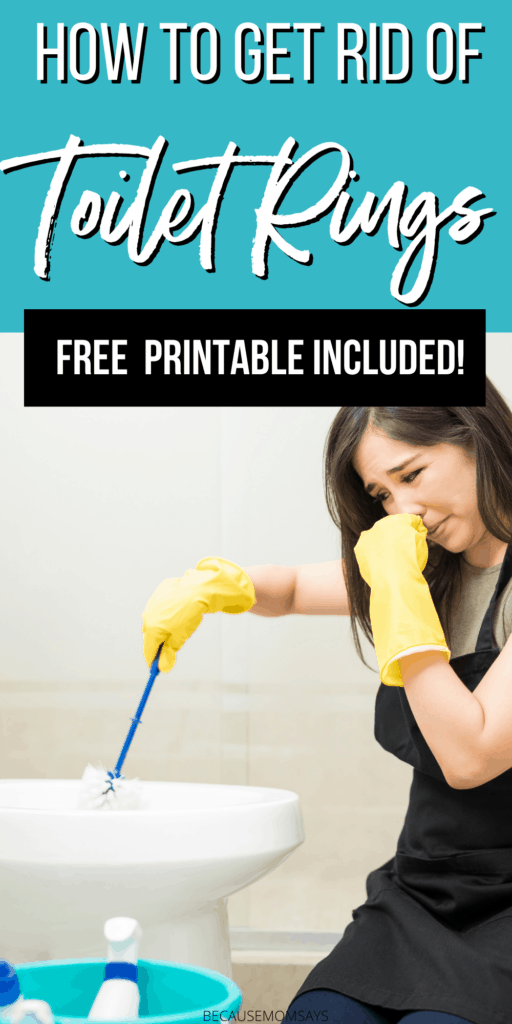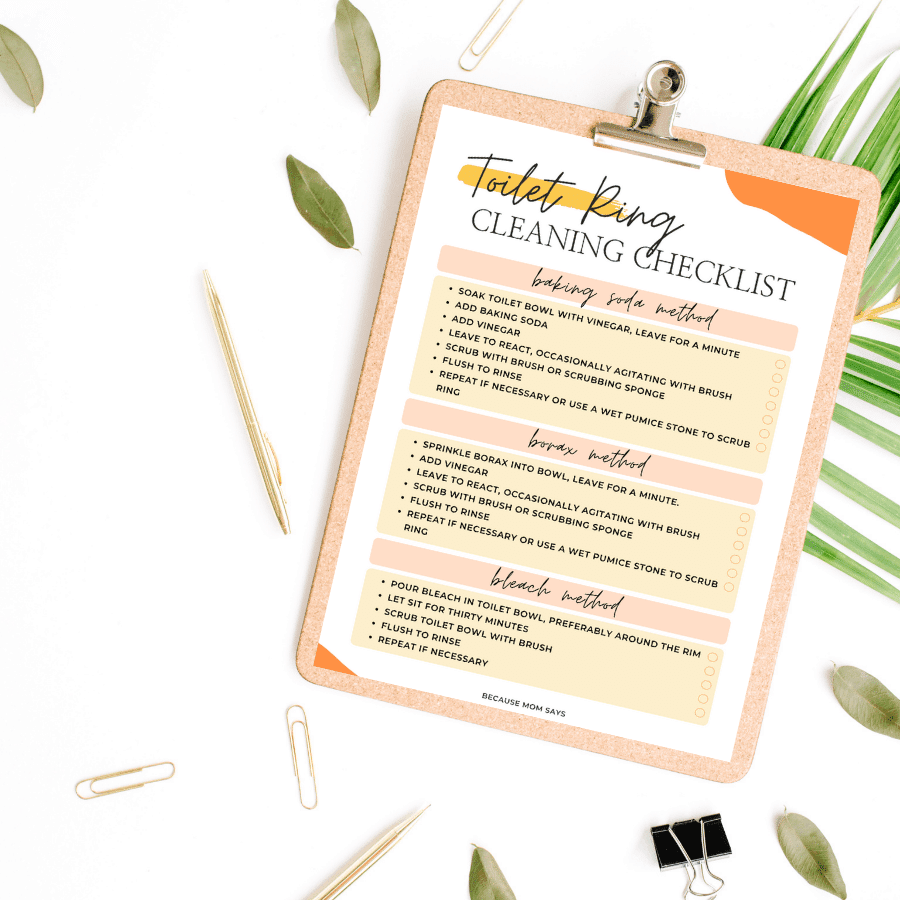I know, I know, this isn’t nice to think about. But it’s something that everyone has to deal with at some point.
Toilet rings are a fact of life, and sometimes they can be incredibly stubborn to remove. You can scrub all you like, but it can seem like your once pearly white porcelain is doomed to have a discolored ring.
But you don’t need to worry about that, with a little guidance and some elbow grease on your part, your toilet bowl can look as good as new before long.
If you’re looking for that guidance, you’re in luck. Ahead, I’m going to explain what causes toilet rings, how to get rid of them and keep your toilet bowl looking nice, and I’ll answer some frequently asked questions.

There may be affiliate links in this article. You can read more about this in my disclosure.
What Causes Toilet Rings
Despite what you may think, toilet rings don’t necessarily mean the toilet doesn’t get cleaned. There are several things that can cause toilet rings, and the method you use to get rid of them may depend on what caused it.
The type of toilet ring can be identified by the color. Most commonly, the ring will be an orange brown color, like rust. This ring is likely due to the type of water that your system uses.
Hard water contains a lot of minerals, which can settle in your toilet bowl and cause staining. Whether you have hard water or not depends on where you live. You can therefore find out whether you have very hard water and whether it could cause problems for you.
If the ring is green, black or a brighter orange, it may have been caused by mold. If the ring is a pick color, this is likely a type of bacteria called Serratia Marcescens which thrives in damp conditions.
Recommended Equipment
Before you decide to work on getting rid of those stubborn stains, you want to make sure you have all the necessary cleaning agents and equipment.
For a cleaner, baking soda and vinegar are very effective and useful to have around the house. They’re also inexpensive. If you want a stronger cleaner, borax will also work. These are best for hard water stains. If your stain is bacteria or mold based, then you may need to use bleach to kill off the infection.
Those are the cleaning agents you need, but what about equipment? Well, first of all, you need some rubber gloves to protect your hands from both the cleaning agents and the toilet bowl itself.
You will also need a toilet brush, and potentially a scrubbing sponge. Finally, you may need a pumice stone, especially if the stain is old and stubborn.
How to Prevent Toilet Rings
Unfortunately, if your system uses hard water, there’s not much you can do to change that other than moving to a different area. However, you can stop rings from forming by making sure you keep on top of your cleaning.
If you clean the toilet using either baking soda, white vinegar, borax, or acid-based toilet cleaners about once a week, then you should see a mineral deposit ring forming. You can do this fairly often, especially if you’re using a gentle cleaner like baking soda.
The easiest way to do this is to simply apply your cleaner just before you go to bed, then let it soak overnight.
In the morning, give it a quick scrub and that should stop a ring forming in its tracks. Regular cleaning will also prevent mold and bacteria building up, as it turns the environment inhospitable for them.

Download your FREE checklist here. If you don’t want to keep printing your checklist, you could also laminate it and use dry erase markers. Here is the affordable laminator I use.
Tips and Warnings
While cleaning the toilet is an ordinary household task, it can be tricky and even dangerous if you’re not careful. Remember to always wear gloves while cleaning the toilet, as you’re dealing with some unpleasant germs.
Also, if you are using bleach, then do not mix it with anything other than water. Bleach can react with all kinds of things, releasing toxic gases. You should even be careful to not mix bleach with hot water, as it will release fumes in the steam.
If you’re using other commercial cleaning products, don’t mix them together for the same reason. Also, be sure to read the manufacturers instructions. In fact, it’s best to clean in a well ventilated room to reduce the risk of you breathing in cleaning fumes.
Your life will be a lot easier if you keep on top of toilet rings, so either sort them out as soon as you notice them or keep up regular cleaning to stop them from resurfacing.
Wash your toilet brush and toilet brush holder regularly as well, it’s often forgotten but kind of obvious that a clean brush works much better and is more hygienic. If you use a pumice stone, disinfect it before uses.
10 Steps to a Sparkling Kitchen
Guide to Removing Hard Water Rings
As said previously, how you get rid of toilet rings depends on what is causing it. So, let’s say you have a problem with hard water, which leaves mineral deposits and causes a rust colored ring. It may be surprising to know that bleach is not the best thing for this job.
That’s because it’s not something alive that needs killing, which bleach is great at, but a deposit of minerals, which needs dislodging more than anything. Bleach might get rid of some of the ring, but it’s mostly whitening the mineral deposit rather than moving it.
Instead of bleach, you want to use something either acidic, to dissolve the minerals, or alkaline, which will corrode the minerals. A combination of the two will dislodge the minerals because the reaction as the acid is neutralized will fizz.
Both borax and baking soda are alkaline. Borax is more expensive, but more powerful than baking soda, although less gentle to you and what you’re cleaning.
When using baking soda and vinegar, first you want to pour a cup of vinegar into the toilet bowl and swish it around, before letting it sit. After a minute or so, sprinkle a cup of baking soda into the bowl and cover with more vinegar. This mixture will fizz as they react, leave it for ten minutes.
Then, use the toilet brush to swish the mixture around and scrub the edges. Don’t flush until the reaction has stopped. If any stains remain, scrub them with the brush or your sponge.
If you’re using borax instead of baking soda, sprinkle a ¼ cup of it into the toilet bowl and then follow with a cup of vinegar. Again, agitate the mixture and don’t flush until the reaction is over. Scrub any remaining stains.
Top 10 Professional House Cleaning Hacks
Stubborn Hard Water Rings
If the stain is old, or you find that it’s not going away, don’t worry. You can repeat this process and see if that helps, but if it doesn’t, then you may need to try something a bit more drastic. This is when you need your pumice stone.
The pumice stone needs to be used extremely carefully and only when absolutely necessary, as it can damage your toilet bowl. However, it will get rid of ingrained toilet rings. Use as soft a stone as you can and make sure the toilet bowl and the stone are wet to prevent scratching as you rub away at the toilet ring.
Some pumice stones are designed to be used this way and even have a handle, these will be less likely to cause damage to your toilet. It is far better to keep on top of it to prevent these stains.
10 Simple Steps to a Clean Bedroom
Mold or Bacteria Rings
If your toilet ring is caused by mold or bacteria, then it may be best to use bleach or a toilet cleaner. Vinegar or borax may work, but the idea here is to kill the infestation as it’s not only unsightly but may be dangerous.
If using bleach, then pour it into the toilet bowl, trying to get it to run down the sides if you can. Let it sit for thirty minutes, then scrub the inside of the toilet with a toilet brush. Be thorough, lifting the toilet seat to get underneath the rim.
Flush the toilet to rinse away the bleach and repeat if necessary.

Download your FREE checklist here. If you don’t want to keep printing your checklist, you could also laminate it and use dry erase markers. Here is the affordable laminator I use.



